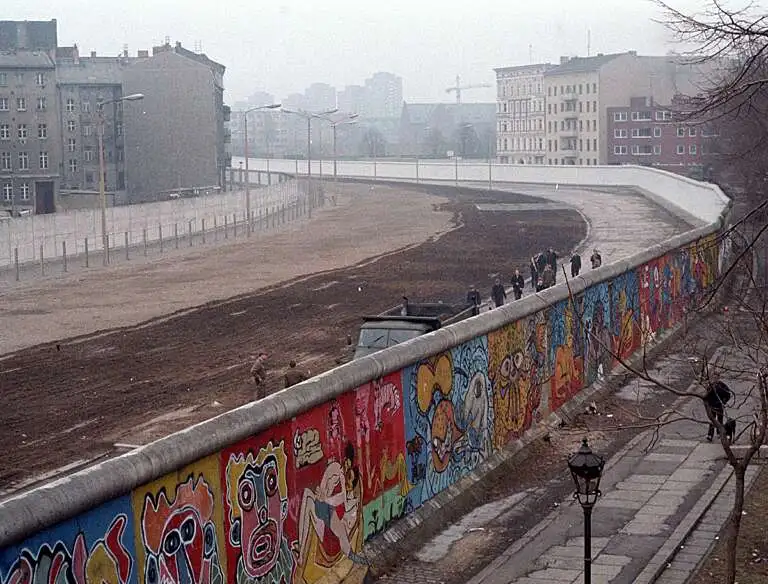
Visiting the Berlin Wall – Richard Clarke
Back in the summer of 1991 I had the good fortune to be invited by the then British Army of the Rhine (BAOR) to be
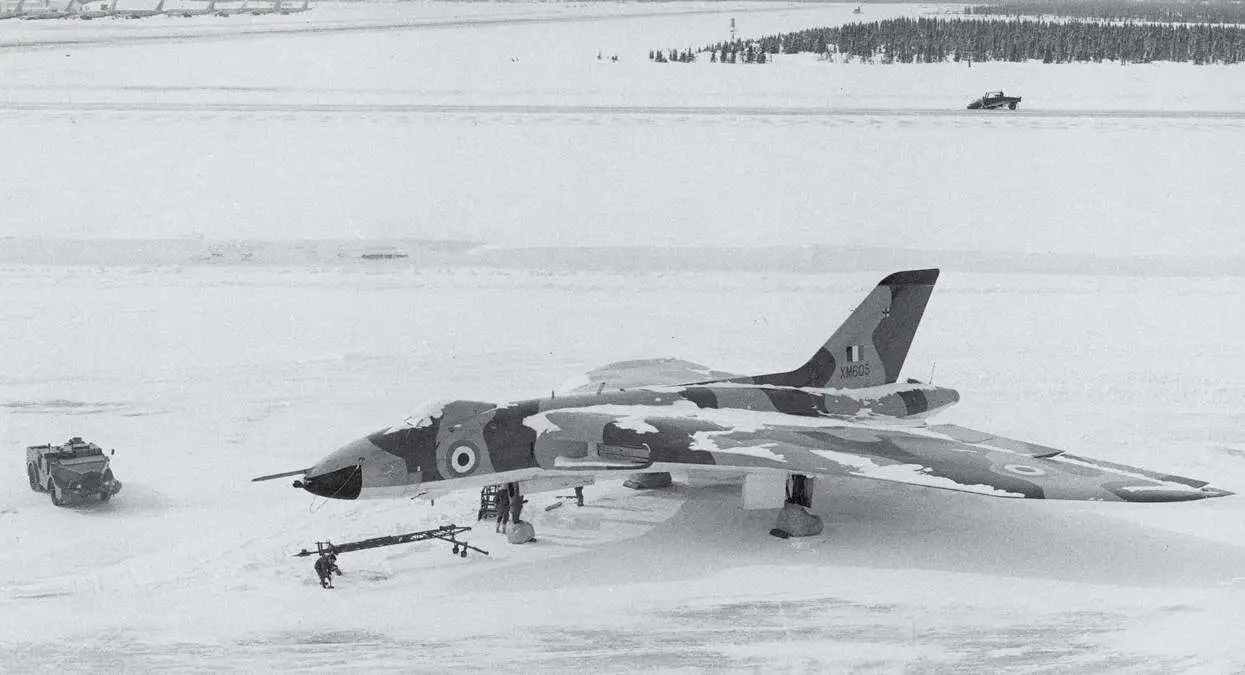
Sometime ago, while casually looking in my flying log book for entries involving XH558, a very similar Vulcan tail number jumped out at me. XH557, sister aircraft to XH558. Both must have come off the production line at the same time. It brought back to mind a quite incredible set of circumstances on 22 September 1967 where a Scampton Blue Steel crew came to be flying a Waddington free fall bomber on a very different and unusual mission. As a result, I decided to finish a memoir I started years ago to record an unusual assignment accomplished by a Vulcan and its crew.
We were a No 27 Sqn crew. Captain, the vastly experienced Flt Lt Francis E Debenham (Deb), Co-pilot Fg Off Mike Ashley, Nav-radar Fg Off Geoff Beer, AEO Fg Off Dennis Wood and me, Nav-plotter Flt Lt Brian Cable. We had been on 27 Sqn for 9 months and were deployed to Goose Bay, Labrador on our first Goose Ranger to practise low flying over uninhabited areas similar in terrain to parts of the Soviet Union.
No 27 Sqn was equipped with the Blue Steel stand-off missile and we normally flew with training rounds loaded so we could simulate missile targeting and launch procedures. On Lone Rangers, however, we flew without the missile and rehearsed low-level flying and laydown attacks in what was called TPF mode. Without the demands of the missile for which I was normally responsible (a somewhat demanding and temperamental mistress most of the time) flying in TPF configuration was relatively relaxing for me.
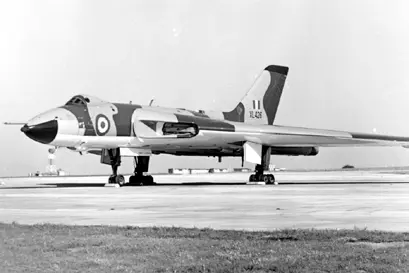
XL426
We left the UK on 19th September and had then flown three high-low-high profile sorties out of Goose Bay on consecutive days. On 22nd the weather around Goose Bay was pretty marginal, so we planned to fly the longest of the Goose Training Routes, heading northwest towards Hudson Bay to find weather suitable for low level. As was often the case with the Vulcan, we had a crew-in snag and sat in the aircraft for over an hour while the ground crew fixed the fault until we could take off some 2 hours later than planned. Consequently, we recovered to Goose Bay 4 hours 45 minutes later in deteriorating weather conditions as low cloud and rain spread in from the west. Shortly after landing, the weather really clamped. We were pleased to have avoided a diversion to Gander and gratefully handed XL 426 back to the hardworking ground crew with a list of snags, including no-go items, that we knew they would fix in time for our return to Scampton on the following Monday.
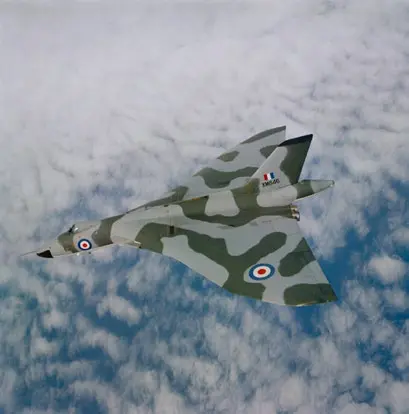
After a busy and tiring week our priorities, were definitely shower, change, beer and then more beer as we dashed from the crew bus through the murk and pouring rain into the Officers’ Mess where the bar had just opened for the evening. We had just about achieved the first two objectives when the telephone at the end of the corridor rang and was handed to Deb with the dreaded words “It’s for you”. The expression on Deb’s face said it all, followed by “Sorry chaps. It’s Sqn Ldr Ops. Wants us to assemble in the lounge and we can’t have a beer”.
Ten minutes later we heard the seriously news that a local man had been badly injured in a car crash on one of the unmade roads around Happy Valley, the local settlement. He had spinal injuries, breathing difficulties and required emergency neural surgery that could not be provided by the small local hospital. Doctors were working to stabilise his condition so that he could be flown to a city with full hospital facilities. The problem was that Goose Bay weather conditions were too bad for any aircraft to land and cloud base and visibility were on the margins for a safe take-off. There were no civilian aircraft at Goose suitable for medical evacuation and the regular Friday evening shuttle flight by Eastern Provincial had been diverted. The USAF had a fleet of KC135 tankers on quick reaction standby to refuel B52 bombers scrambled from US bases in the event of war. Understandably, their deterrent mission was paramount and they could not release an aircraft. The Canadian authorities had approached the RAF Detachment for help knowing that two Vulcans were on deployment. The crew chiefs had checked and reckoned a stretcher could be stowed in the bomb aimer’s prone position. One of these, XL426, was unserviceable. XH557 was serviceable, but her crew had hit the Officers’ Mess bar at opening time and were now into their second or third beers. That left us.
While we changed back into flying kit and had a much-needed meal, the well-oiled machine of the Goose Detachment’s small operations team got underway. The necessary approvals from Scampton, Waddington and HQ 1 Group had to be obtained, slightly complicated by a four-hour time difference that made it approaching 2300 hrs on a Friday evening. Both stations were manned for their QRA commitment and responded quickly. Scampton’s view was “Why did you ask? Get on with it”. There was a slight delay from Waddington as we were borrowing one of their aircraft. They came back with a similar response with the caveat, “Please don’t break 557 as well!” HQ 1 Group were far more reticent. Flexibility had never been a strong point on the V-force. They needed to know where we were going and when. Unfortunately, Sqn Ldr Ops could only reply, “We don’t know yet”. But very quickly, after he had explained the whole situation to a senior duty officer, he came back to us with the clearance for Deb to use his judgement, self-authorise, for which he was well qualified, and use common sense on crew duty times and weather – ie “Get on with it”.
The serious business started then. We learned very quickly that there were complications around the eventual destination for our casualty. We heard that his medical condition was still very serious and would need to be stabilised before undertaking the stress of a flight in any aircraft let alone a Vulcan. Another problem, apparently came out of who and how his treatment would be funded, something that was a bit beyond our understanding, thanks to the NHS. The weather was pretty terrible and destinations on the east coast, namely Gander or Halifax, Nova Scotia, were closed to all flights. To fly our casualty to a US hospital was really out of the question, because of immigration and border complications, although we could have done so if really necessary. By this time, it was about 20:00 hrs and the Goose Bay weather was still below limits for take-off with visibility less than 200 metres and the cloud base virtually at ground level in steady rain. Airfields to the west were not much better, but the weather system was moving eastwards fairly steadily so we could expect improvements over the next few hours. Common sense and geography said that the number of options for our eventual destination was limited:
Quebec 590 nm – 1 hr 40
Montreal 700 nm – 2hrs
Ottawa 780 nm – 2hrs 15 min
Toronto 955 nm – 2hrs 40 min
After their original horror at the thought of carrying a seriously injured casualty in a Vulcan, the medics had only one reservation about the effects of cockpit pressurisation on a patient with breathing difficulties. We addressed that by planning to limit our maximum altitude to 25,000 feet where we could maintain cabin altitude at more or less sea level pressure. That meant we had to fly outside our normal parameters.
Routinely, we flew well above the airways. Fuel consumption would be higher at lower levels and we would need to fly most of the route in controlled airspace down amongst civil traffic. The thought of this was slightly disturbing because none of us had any experience of flying in North American airways or of procedures at civil airports. We also had to ensure that we arrived below maximum landing weight and get XH 557 de-fuelled accordingly, not forgetting that the weather everywhere was forecast to be pretty grim so we could need fuel for diversion. Suddenly, we became very busy planning contingencies for all the possible options. Fortunately, nearly all our potential destinations were roughly along the St Lawrence River and the Great Lakes and the airways structure generally followed the river for several hundred miles. While I prepared four flight plans, Mike did four sets of fuel calculations and Deb and Dennis studied route procedures and standard arrival charts for each of the airfields and alternates. I think our Nav Radar, Geoff, went hunting for food and then went to sleep in a chair!
We had hurried up. XH 557 had been defueled, probably to about 80% in the main tanks. We had set the aircraft to readiness 15 for a quick getaway, now we had to wait. We were promised an “Update in half an hour”, on four or five separate occasions so it was clear that the medics were still working on stabilising their patient and his eventual destination remained uncertain. Getting some proper rest was out of the question so we sat around the Ops room trying to catch the odd 40 winks which was difficult due to the quantity of coffee we had consumed.
At about 0200 hrs, the ops phone rang for the umpteenth time that night. Sqn Ldr Ops uttered a single word, “Montreal”. At least we could complete our preparations. The fuel configuration was OK thanks to Mike Ashley’s best guess and I finished off the air traffic flight plan that gave our airways route to join a standard arrival procedure at Montreal Dorval International Airport. We used our RAFAIR Callsign plus the suffix “Medevac” and in Field 18 (special requirements) of the flight plan I inserted what turned out to be the magic words “STS/MEDEVAC”.
An hour later we were told that our casualty was about ready to be transported to the aircraft accompanied by a doctor who would travel with us. We crewed in. The pilots and AEO climbed into their seats and completed final checks with the pilots’ ejector seat pins removed by the crew chief. We had already come to the conclusion that with seven on board there would be no room for him to travel with us. The crew were all qualified to fuel and turn-round the aircraft, so it was not a problem, but it was reassuring to have him and our own crew chief bustling around making sure everything was OK for our sortie.
Geoff and I sheltered from the rain under the wing ready to help with getting our casualty on board. We waited some time, but eventually we saw a convoy of vehicles making its way round the perimeter track towards us, emergency lights flashing. Nothing in North America is done on a small scale and the ambulance was no exception. It was huge and loomed over us as it reversed slowly towards the aircraft. The ambulance crew leapt out and within a few seconds had the stretcher ready to load. When the crew chief pointed to the Vulcan cockpit entrance door it stopped them dead in their tracks. They had clearly seen nothing like it before. While the ensuing conference with our groundcrew was taking place, I introduced myself to the doctor. He was a diminutive man of Chinese/Innuit origin with an almost incomprehensible accent. He announced himself as Tseng (that’s as close as I could guess and will have to do for the purposes of this narrative). He was clearly terrified. Looking back, I can understand why. It was a pitch-black night, wet and windy with standing water everywhere that reflected the myriad of sodium lights and the flashing aircraft anti-collision lights competing with those of the emergency vehicles surrounding us. All of which was very disorientating to say the least and it was not helped by the noise of ground power units blasting away to add to his sense of confusion. He must have thought he had descended into Hell! We tried to reassure him without much success, but managed to get him into a flying suit, loaned by Dennis Wood our smallest crew member, which still seemed enormous and fitted where it touched. It had to do.
Meanwhile, the crew chiefs and the ambulance crew tried to load the stretcher, complete with heavily sedated casualty securely strapped to it, up through the crew hatch and into the bomb aimer’s prone position. The stretcher was about 70 percent in when proceedings came to a halt. A long pause was followed by the stretcher being extracted very gingerly and returned to the ambulance. Shouting above all the noise the crew chief explained in very colourful language that the stretcher was enormous and would not fit into the cockpit. It was a devastating moment, but one should never underestimate the ingenuity of RAF groundcrew. I vaguely remember the stretcher might have been a gurney with its own extending legs and wheels and I think it was modified in the back of the ambulance, because after a long 10 minutes or so, the chief announced he thought it would fit now. Another insertion attempt followed and it went into the bomb aimer’s position about 70 percent of the way, but still protruded out into the rear crew compartment obstructing the crew exit. It was also impossible to close the entrance door with the crew ladder folded and fitted on the door as was standard procedure. By this time, we were becoming more and more aware of the urgency of the situation and the need to get our man to hospital.
Out came the stretcher again while we had yet another rethink. By this time the doctor was totally convinced he was in Hell, but he spent the time checking his patient and ensuring he was as comfortable as he could be in the circumstances.
We decided that the only way we could get our man to hospital was to load the crew and the doctor first, then remove the ladder which would be stowed in the bomb bay pannier. The ground crew would pass up the stretcher and we would lash it securely and close the door. Once the stretcher was in place and the door was closed there was no escape route for the rear crew or our passengers. There was a suggestion from up front that the pilots should fly with their ejection seats safe, because we had no escape, but a short sharp riposte from the back settled that and the pins were removed and stowed.
We managed to persuade a very unwilling Dr Tseng to climb the ladder. We then had fun and games getting him settled in the 6th seat, plugged into conference intercom and his oxygen supply. He was near panic when I fastened his oxygen mask and clamped it securely on his face, but by that stage I think he realised he had no choice. The poor chap subsided and accepted his fate although not very gracefully.
That done, things moved very quickly. The stretcher slid in, with the casualty securely strapped and manoeuvred carefully, feet first, onto the bomb aimer’s prone position. Geoff and I secured it along with Dr Tseng’s large black doctor’s bag and another substantial black case. The crew compartment was full to capacity!
By the time the door was closed, all four engines were winding up and we were cleared to taxi. A few minutes later XH 557 turned onto the Goose runway and Deb started a rolling take off run. Anyone who has had the experience of a Vulcan take off relishes the feel of 80,000 pounds of thrust and almost brutal acceleration, but Deb eased the throttles open gradually, using more runway than usual along Goose’s 12,000 ft of concrete, in a silky-smooth acceleration to rotate speed. It was a Rolls Royce take off and our sedated patient would not have noticed a thing.
It was about 0445 hrs and the skies over Eastern Canada were empty as we received procedural clearancefrom Monckton Area Control Centre to climb to flight level (FL) 240 and join airways. In those days there was no radar cover for about 150 nm until we got closer to the USA border. We settled into our usual routine. I had been detailed to look after our passengers for the simple reason that Dennis would be busy with the aircraft electrics and the R/T and I was the only crew member who could actually get to the left side of the crowded cabin where our doctor passenger was sitting. As we levelled out at FL240, I had just completed my TOC routine with a radar fix from Geoff and made a small heading alteration, when he gave me a firm nudge and pointed to Dr Tseng.
The poor guy was having a panic attack. He was shaking from head to foot, uncontrollably. Above his oxygen mask I could see the whites of his eyes were rolled upwards and he was clearly hyperventilating quite badly. Geoff and I had switched to conference intercom and, fortunately, that left the pilots blissfully unaware of events in the back while we had a hasty conflab on what to do. I moved across into the tight space between Dr Tseng and the stretcher and tried to reassure him, but he was clearly on the verge of hysteria and it did not help that he was jabbering in Chinese as well as thrashing around. Eventually I grabbed him by the arms and held him firmly in his seat so that he could not harm himself. Just as I was wondering what the Hell to do next, Geoff shouted that our patient was having difficulty. His sedation had begun to wear off and although still unconscious, he was obviously in distress. In desperation, I shook the good doctor none too gently and forced him to look at the stretcher. The effect was instantaneous as if a switch had been thrown. His concern for his patient overcame his fear and he was back to being a doctor in a second. Geoff passed him his black bag and he set to work in calming his patient and we breathed a sigh of relief! Next up, he was pointing at his second black case indicating Geoff should open it. It contained a portable oxygen kit. This caused us even more consternation as the last thing needed in a confined Vulcan cabin was a stray source of 100% oxygen, even though our casualty clearly needed it. With a bit of quick thinking, Geoff passed over the 7th seat wander lead oxygen/intercom assembly, which had a spare mask and headset fitted, and turned the regulator to 100% oxygen with slight over pressure. Dr Tseng cottoned on very quickly and pushed the mask into position on his patient’s face, while I fitted the headset to keep it in place. A couple of minutes later all was calm as he returned to a deep sleep with his doctor watching over him like a hawk. Geoff and I both took a deep breath and returned to our navigation duties. The entire episode had lasted barely more than a few minutes and, in that time, XH 557 had swept us further westwards towards our destination and radar contact with ATC which was still some distance way.
Dennis initiated a routine handover from Monckton ACC to Montreal ACC, including the word “Medevac” in our callsign. We were immediately allocated a secondary surveillance radar code, known as a “Squawk”, unique to Medevac flights. This would alert all ATC facilities to our mission and worked like magic as soon as we flew into radar contact. The Montreal controller asked if we were capable of area navigation and on hearing an “Affirmative” told us that we were cleared for direct flight to Montreal Dorval Airport, outside airways if necessary. A small alteration of heading made the required adjustment to track. After another 30 minutes or so we were cleared to descend and started a slow descent from 120 miles out to minimise any discomfort for our casualty who was still in a deep sleep, much to our collective relief. I climbed out of my seat to explain to the doctor what was about to happen and a grateful look of relief appeared on his face at the prospect of an end to his ordeal!
The radios became quite busy as we got closer to Montreal. We could hear the approach controller giving instructions to other aircraft, advising we were a Medevac and passing instructions to keep them clear so we had priority. At about 30 miles, we were cleared for a straight in approach to the westerly runway. It was just about daylight with a watery dawn. Much to our relief, the weather had cleared, with a high cloud base and good visibility. Mike made visual contact with the runway lights at 5 miles as the landing gear was lowered with a slight rumble and the engine power increased slightly to compensate for the increased drag. Deb’s landing was feather-light. The altimeter and airspeed indications were the only signs that the aircraft had crossed the runway threshold and touched down. We did not feel the main bogeys at all and the first sensation of being on terra firma again was the vibration of the nose wheel as it made contact. As we cleared the runway, Mike reported a reception committee of fire trucks and emergency vehicles moving to follow us and Deb rolled into position behind a “Follow Me” vehicle which led us towards the Airport Terminal. The ever-efficient Dennis asked Ground Control for a step ladder so we could get into the bomb bay and within minutes XH557 rolled to rest outside the Airport Main Terminal.
While the pilots and Dennis completed the shutdown procedures, our next problem in the back was to extricate ourselves and our passengers from the packed confines of the crew cabin. Easier said than done. However, once the stretcher had been unlashed it was just possible for me to operate the door release and squeeze past to slide very inelegantly down to meet the reception committee of ground crew and paramedics assembled below. It only took a few words of explanation and a couple of seconds for the paramedics to realise the situation and, between us, with Geoff’s help from above, the stretcher and our casualty slid slowly and carefully down the door onto a waiting trolley. There was a moment of comedy as Geoff having helped Dr Tseng divest himself of his safety equipment, encouraged him to slide down the door. In his desperation to get out of his Hell hole he did so with such enthusiasm that he knocked me for six and we both ended up on the tarmac. However, his main concern immediately returned to his patient as he supervised the transfer to the waiting ambulance and disappeared on board at speed. Two seconds later he reappeared, agitated as could be, to collect his bags that Geoff had lowered from the cabin. He rushed back onto the ambulance, only to reappear yet again with Dennis’ flying suit which he thrust into my hands saying “Thank you, thank you, thank you” over and over again. The relief at the end of his ordeal was written all over his face. Then he was gone and the ambulance left at speed with a police car leading the way.
This was the last time we ever saw or heard of Dr Tseng and our casualty as we returned to our normal roles. Dennis asked one of the groundcrew if our step ladder had arrived and was helpfully directed towards a truck with a set of 707 steps in tow! This was soon rectified by one of the maintenance crew who had a ladder on his pickup truck. The door ladder was retrieved from the bomb bay pannier. Mike, Dennis and Geoff attended to refuelling the aircraft and post flight checks while Deb and I headed for the Operations Centre
We were greeted by a cheerful dispatcher who welcomed Deb with a couple of messages and directed him to a phone so he could respond immediately. I set about filing a flight plan for our return to Goose Bay and was immediately interrupted by our friendly dispatcher who shoved a large printed form in front of me and asked for a signature. It turned out to be a large bill for landing fees, handling charges and aircraft parking and when I queried it, he pointed out that it was standard procedure and XH557 was parked in the prime position right opposite the main terminal and public viewing platform for which airlines paid extra. I can’t remember the exact figure, but it was hundreds of dollars! He helpfully explained that if we had parked on the military side of the airport at CFB St Hubert’s, these costs would not have been levied under the standing NATO agreement. Detecting I was far from happy, the dispatcher called for his shift manager who appeared from the back-blocks. He took one looked at the paperwork, tore it in pieces and declared. “You guys have just done a great service for one our citizens, it’s on the house.” As this conversation ended, Deb returning from making his phone calls said with relief, “Thanks. I’d have had trouble explaining that to 1 Group”.
His calls had been to Sqn Ldr Ops at Goose who had been directed by HQ 1 Group to advise us that we should do a quick turn round and fly back to Goose Bay. Sqn Ldr Ops had to remind them gently that we had been on duty for over 24 hours and we were going nowhere until we’d had some sleep. The second message was from the British High Commission in Montreal who had arranged transport and accommodation for us at CAF St Hubert’s Officers’ Mess and for the Royal Canadian Mounted Police to provide a 24-hour guard for the aircraft. True enough, by the time we had finished in Operations and walked back to XH557 there was a large black station wagon with RCMP markings alongside the aircraft and two Mounties, complete with breeches and traditional flat brimmed campaign hats. After a short conversation between the Mounties and Deb, we were left in no doubt that XH557 was in safe hands.
Refuelling was soon complete and we were ready to head for some well-earned sleep, when a minibus drove up. A very smartly besuited young man introduced himself as a member of the High Commission Staff who had been detailed off to make sure we had everything we needed. A short time later we were deposited at the Officers’ Mess with the young man’s card and an invitation to visit the British Pavilion at Expo 67 as guests of the High Commission. This was the last thing any of us wanted at that particular moment! The rest of the day is only a hazy memory. It was still only about 0800 hours. We were shown to our rooms and crashed out. I felt I could sleep for a week and was out for the count within seconds of my head hitting the pillow. Three hours later I was wide awake and wondering where the Hell I was. No chance of going back to sleep and in desperate need of coffee and ravenously hungry, after a quick shower and shave I found myself in the dining room where a Canadian brunch was laid out. By the time I’d had a cup of coffee, the rest of the crew arrived. We had clearly all had our circadian rhythms completely screwed up by the events of the past 24 hours. I vaguely remember a plan being formed, a couple of phone calls and early afternoon we were chauffeured to Montreal Expo 67 and to the imposing British Pavilion. We were made very welcome and had a brief conducted tour of Expo 67, as I recall, before “tea” back at the British Pavilion at which some perceptive individual provided us with a supply of cold beer. Shortly afterwards, we were all fading fast and headed back to St Hubert’s for an early dinner and a night’s sleep.
Sunday dawned clear and bright, with not a cloud in sight, in a brilliant Canadian autumn sky. Right on time, our mini-bus arrived and we headed for the airport. As we approached the terminal, we could see the viewing platform on top of the building was crowded with people. We had been told that Montreal Dorval was very quiet on Sundays and one of us enquired casually of our driver what was going on. He replied, “You are, sir. Your emergency flight made TV news last night and they are all here to see you and the Vulcan.” On a second glance there were hundreds of on-lookers to see us off.
The Mounties, true to their word, were still guarding 557. They departed with a smart salute and “You’re welcome”. Flight planning and crew-in was routine and uneventful and as we checked in with ground control over the R/T, we were cleared to start engines with instructions to taxi for the western runway. I heard Dennis ask for clearance to turn back over the airfield after take-off and for an unrestricted steep climb. We felt the assembled crowd deserved something to make their early start memorable indeed. With no other traffic to concern us, XH557 rolled onto the runway and Deb opened the throttles for take-off. With 75 per cent fuel on board the acceleration was exceptional and 557 leapt into the air. We climbed and turned to pass along the runway at 2000 ft, accelerating to 300 knots. Deb eased the stick back into a steep climb, giving the crowd (and probably most of Montreal) the full benefit of 80,000 lbs of thrust as we roared up into the clear blue sky. Dennis called departure control who responded, “Clear en-route, unrestricted climb, call passing seven thousand”. Dennis gave the laconic reply, “RAFAIR passing eleven thousand.” XH557, for a short while an angel of mercy, was once again Vulcan, God of Fire, and back in its element as it soared towards 41,000 ft and points east to Goose Bay.
EPILOGUE
Our return flight to Goose Bay was uneventful and we handed back a fully serviceable XH557 to a relieved Waddington crew chief. We had no specific debrief on our mercy flight and the next day headed home to Scampton in a repaired XL 426. The next few months were busy and none of us gave much thought to events of early September, although we had realised early on with some shock that none of us ever knew the identity of our casualty or the real name of our doctor. The entry in the Authorisation Sheet referred to 2 x passengers – no names. It was 18 months before I returned to Goose Bay on a Lone Ranger flight and in that time, the whole of the RAF detachment had been rotated. Also, much of the civilian population of Happy Valley and its environs was transient and medics came and went, since conditions in Labrador were often extreme and sometimes the frontier spirit did not last more than a year. My attempts to discover any information about our casualty came to nothing. All the medical staff who were stationed there in 1967 had moved on and there appeared to be no record of our casualty’s accident or the outcome. To this day, I do not know if he lived or died, recovered or spent his life as an invalid. It was as if he and the doctor had never existed and I guess that concern wandering about in the back of my mind has kept my recollection of events so alive for 53 years.
On reflection, our Montreal saga had been a surreal experience full of tension, early uncertainties and an all-pervading sense of urgency. There had been periods of pathos, emotion and downright comedy. Everyone involved, from the Goose Detachment, Scampton, Waddington, HQ 1 Group, the Canadian authorities and their people, not to mention the British High Commission, had shown great commitment and goodwill to help an unknown and possibly unknowing Canadian citizen. The Vulcan was the most unlikely aircraft to serve as an air ambulance and XH557 was almost certainly unique in that respect. Moreover, it was probably the only Vulcan ever to have the honour of a dedicated guard from the Canadian Mounties!
We in Deb’s crew had done our bit and the final entry in the Flight Authorisation sheet, in Deb’s scratchy handwriting, would have summed it all up very neatly:
“DCO” – Duty Carried Out.
Wing Commander Brian Cable MBE RAF (Ret’d)
13 November 2020

Back in the summer of 1991 I had the good fortune to be invited by the then British Army of the Rhine (BAOR) to be
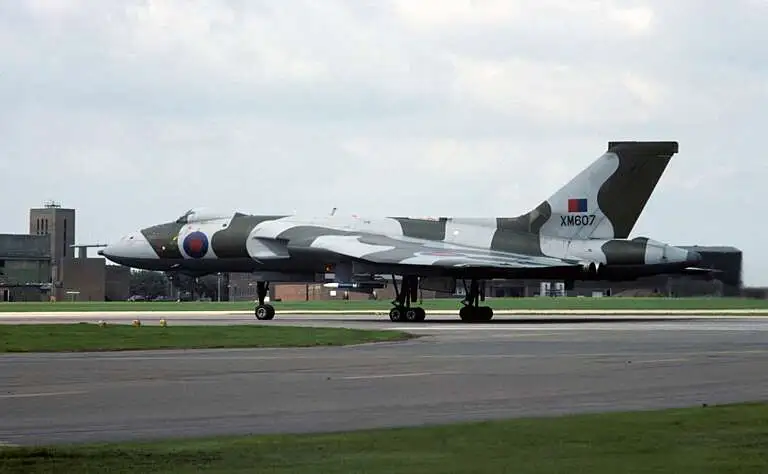
Following the transfer of the strategic deterrent role to the Royal Navy’s Polaris fleet, on 30th June 1969, the RAF maintained three nuclear-capable Vulcan wings
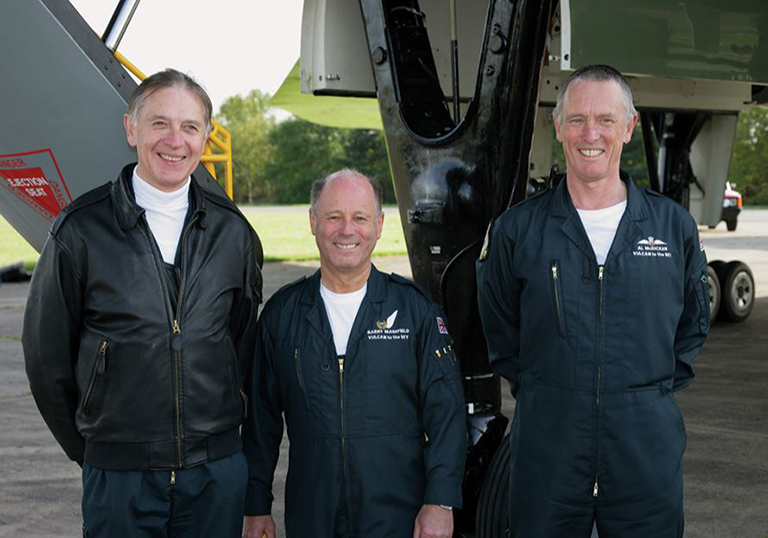
Barry Masefield was the Air Electronics Officer (AEO) for Vulcan XH558 and had flown in this iconic aircraft for over 30 years, also being a key
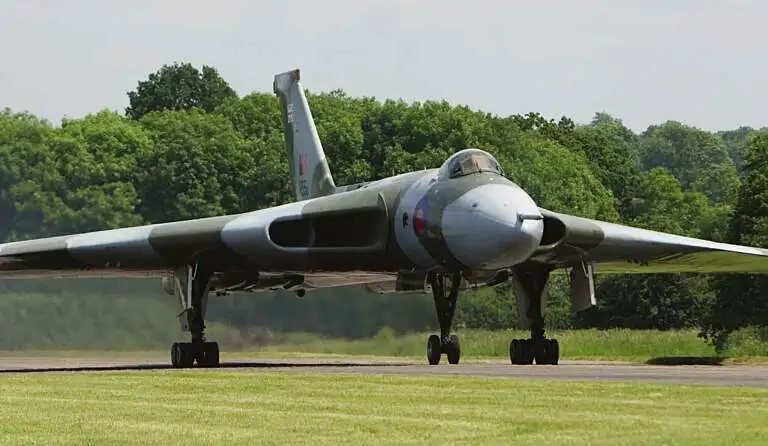
The race was on again to prepare XH558 for the 2009 airshow season. A host of servicing requirements awaited the attentions of the Trust’s engineering